
Table of Contents:
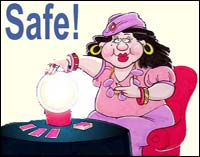 That sizeable mob of fortune-tellers in Los Angeles is now safe from unwanted government regulation. Los Angeles police commissioners have rejected a proposal designed to regulate the fortune-telling industry by requiring soothsayers, Tarot card readers, psychics and the like, to obtain government licenses. They did this, they say, because issuing licenses would have the unintended effect of misleading consumers into believing that "these people are somehow qualified to practice their trade."
That sizeable mob of fortune-tellers in Los Angeles is now safe from unwanted government regulation. Los Angeles police commissioners have rejected a proposal designed to regulate the fortune-telling industry by requiring soothsayers, Tarot card readers, psychics and the like, to obtain government licenses. They did this, they say, because issuing licenses would have the unintended effect of misleading consumers into believing that "these people are somehow qualified to practice their trade."
Hmmm. Very much like the issuance of a patent by the US Patent Office on any crazy notion, implies that the idea, invention, process, actually exists or works? They may have a point there.
Los Angeles vice squad police report that they get about fifty complaints a year about tricks practiced by those who claim to consort with spirits, the average loss per victim being about $5,000. The proposed ordinance would have required those who traffic in the mystical-for-profit racket to get a license, and post their rates and complaint procedures.
But wait a minute. Bob Butterworth, the former Attorney General of the State of Florida went on record as being in favor of having fortune-tellers in this state licensed, but said that it would not be possible to have that carried out, because "no one can test psychic powers." That was news to me, folks. Here at the JREF we design and suggest just such procedures, on a daily basis; that's our business. And we offered our services — free of charge — to Butterworth, who didn't even trouble to respond to that offer.
It's clear: don't fuss with the need of the naïve to hold silly notions. It could cost votes, and in Florida we have a hard enough time just counting what we get in that contest....
What follows was prompted by comments sent in by readers about my observations on my late friend Richard Feynman, one of my now-deceased giants, and his intense curiosity about sometimes minor matters that became important because they might lead him to grander conclusions. Think of Fleming noticing mold in a Petri dish....
I've dealt before here with an interesting gentleman, Sir David Brewster (1781-1868) — "K.H., LL.D., F.R.S., V.P.R.S.E., &c. &c." — as he's listed on the frontispiece of his book, "Letters on Natural Magic," 1831. In my admittedly meager collection of old and rare books — ensconced in the JREF library — I have an 1842 copy of this book, listed as "No. 98" in a Harper Brothers series, "School District Library." Badly penned into the beginning of the volume is "The Property of School District City of Cobleskill (?)" (This book was also issued in 1832 as a first American edition, # 50 in the Harpers Family Library series.) Brewster rather fits the profile of an earlier Feynman.
While Sir David could be a bit naïve — almost fatally so in a very few subject-areas — he generally handled puzzling matters quite efficiently. In fact, he was a huge contributor to science in many respects. You can find an excellent profile on the man at www.brewstersociety.com/brewster_bio.html.
Here is what he had to say about an interesting and puzzling event, the kind of thing about which Dick Feynman would have similarly had something to say:

In the course of writing the preceding observations, an ocular illusion occurred to myself of so extraordinary nature, that I am convinced it never was seen before, and I think it far from probable that it will ever be seen again. Upon directing my eyes to the candles that were standing before me, I was surprised to observe, apparently among my hair, and nearly straight above my head, and far without the range of vision, a distinct image of one of the candles, inclined about 45° to the horizon, as shown at A in Fig. 2. The image was as distinct and perfect as if it had been formed by reflection from a piece of mirror glass, though of course much less brilliant, and the position of the image proved that it must be formed by reflection from a perfectly flat and highly polished surface. But where such a surface could be placed, and how, even if it were fixed, it could reflect the image of the candle up through my head, were difficulties not a little perplexing. Thinking that it might be something lodged in the eyebrow, I covered it up from the light, but the image still retained its place. I then examined the eyelashes with as little success, and was driven to the extreme supposition that a crystallization was taking place in some part of the aqueous humour of the eye, and that the image was formed by the reflection of the light of the candle from one of the crystalline faces. In this state of uncertainty, and, I may add, of anxiety, for this last supposition was by no means an agreeable one, I set myself down to examine the phenomenon experimentally. I found that the image varied its place by the motion of the head and of the eyeball, which proved that it was either attached to the eyeball or occupied a place where it was affected by that motion. Upon inclining the candle at different angles the image suffered corresponding variations of position. In order to determine the exact place of the reflecting substance, I now took an opaque circular body and held it between the eye and the candle till it eclipsed the mysterious image. By bringing the body nearer and nearer the eyeball till its shadow became sufficiently distinct to be seen, it was easy to determine the locality of the reflector, because the shadow of the opaque body must fall upon it whenever the image of the candle was eclipsed. In this way I ascertained that the reflecting body was in the upper eyelash, and I found, that, in consequence of being disturbed, it had twice changed its inclination, so as to represent a vertical candle in the horizontal position B, and afterward in the inverted position C. Still, however, I sought for it in vain, and even with the aid of a magnifier I could not discover it. At last, however, Mrs. B., who possesses the perfect vision of short-sighted persons, discovered, after repeated examinations, between two eyelashes, a minute speck, which, upon being removed with great difficulty, turned out to be a chip of red wax not above the hundredth part of an inch in diameter, and having its surface so perfectly flat and so highly polished that I could see in it the same image of the candle, by placing it extremely near the eye. This chip of wax had no doubt received its flatness and its polish from the surface of a seal, and had started into my eye when breaking the seal of a letter.
 Randi comments: Bear in mind that Brewster is referring to dark red sealing-wax, a hard, shiny, substance usually shaped into sticks, and made liquid by heating with a direct flame, unlike what we today usually think of as "wax." It tends to take a very sharp impression of whatever it's in contact with as it cools and thus hardens.
Randi comments: Bear in mind that Brewster is referring to dark red sealing-wax, a hard, shiny, substance usually shaped into sticks, and made liquid by heating with a direct flame, unlike what we today usually think of as "wax." It tends to take a very sharp impression of whatever it's in contact with as it cools and thus hardens.
That this reflecting substance was the cause of the image of the candle cannot admit of a doubt; but the wonder still remains how the images which it formed occupied so mysterious a place as to be seen without the range of vision, and apparently through the head. In order to explain this, let m n Fig. 2, be a lateral view of the eye. The chip of wax was placed at m at the root of the eyelashes, and being nearly in contact with the outer surface of the cornea, the light of the candle which it reflected passed very obliquely through the pupil and fell upon the retina somewhere to the left of n, very near where the retina terminates; but a ray thus falling obliquely on the retina is seen, in virtue of the law of visible direction already explained, in a line n C perpendicular to the retina at the point near n, where the ray fell. Hence the candle was necessarily seen through the head as it were of the observer, and without the range of ordinary vision. The comparative brightness of the reflected image still surprises me; but even this, if the image really was brighter may be explained by the fact, that it was formed on a part of the retina, upon which light had never before fallen, and which may therefore be supposed to be more sensible, than the parts of the membrane in constant use, to luminous impressions.Independent of its interest as an example of the marvellous in vision, the preceding fact may be considered as a proof that the retina retains its power to its very termination near the ciliary processes, and that the law of visible direction holds true even without the range of ordinary vision. It is therefore possible that a reflecting surface favourably placed on the outside of the eye, or that a reflecting surface in the inside of the eye, may cause a luminous image to fall nearly on the extreme margin of the retina, the consequence of which would be that it would be seen in the back of the head half way between a vertical and a horizontal line.
Yes, I can see Dick Feynman relating to such an investigation. Now, nothing Earth-shaking was developed as a result of this foray of Brewster's curiosity, it's true. But he found an answer, and that was enough for him. This impels me to tell you about my grandfather's "imaginary friend." Sometimes it happens that the most incredible story, too good to be true, has to be looked at a second time.
My paternal grandfather, George Nicolai Zwinge, was born in Austria in 1876. When he was only a few months old the family moved off to Copenhagen, Denmark, became citizens of that country, and settled down. The father of the family was a shipbuilder who found work on the local docks. He would leave for work very early in the morning, before the rest of the family was awake. Every day young George went off to school while it was still dark, and his mother would hand him his dad's lunchbox; since granddad went right by the shipyard on his way to school, it was his chore to drop off the father's lunchbox.
When he was less than ten years of age, shortly after Christmas, Gramps suddenly began telling fanciful tales about an Imaginary Friend that he said he met on the way to school each morning, an impressive man with a moustache, wearing a tall black fur hat, astride a fierce black horse and accompanied by other bearded men wearing swords. He also said that there were huge dogs almost as tall as he was, held on long leashes, and held back from attacking him. He referred to his Friend as, "Mr. Christian."
Little George would run on and on about Mr. Christian's interest in his family, and would report his reaction to accounts of such things as a temporary illness of his mother, invariably conveying Christian's concern and his good wishes. This imaginary man seemed harmless, as well as interested in George and the family.
The family was content to allow George to indulge in this bit of fantasy for two or three months, and then his father decided to take him aside and have a serious talk about the matter. He gently told his son that a bit of storytelling was understandable, but that he seemed to have been carried away in developing the tale far beyond an innocent and rather understandable joke — and he firmly declared an end to the fantasy.
But George insisted that Mr. Christian was very real, that the whole scenario was an actuality, and that he had not been lying or making up all the details, either. It got to the point where his father began to get angry, and simply declared that he'd hear no more of it. George was silenced on the subject, and the reports of his encounters ceased. Relationships between George and his father deteriorated substantially. This Imaginary Friend had come between them, and each one of them maintained his opposite position.
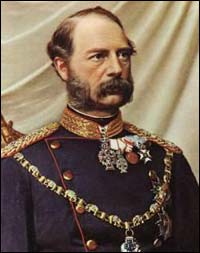 Two months passed. Seated in the living room before an after-dinner fire, the father opened the evening paper. "Father," said George, pointing at an illustration, "that's Mr. Christian." There on the front page, seated astride his black horse, with the rococo Amalianborg Palace in the background, was His Royal Highness Christian IX of Denmark, in all his glory. The newspaper was announcing the Royal birthday. There was a great silence in the Zwinge living room....
Two months passed. Seated in the living room before an after-dinner fire, the father opened the evening paper. "Father," said George, pointing at an illustration, "that's Mr. Christian." There on the front page, seated astride his black horse, with the rococo Amalianborg Palace in the background, was His Royal Highness Christian IX of Denmark, in all his glory. The newspaper was announcing the Royal birthday. There was a great silence in the Zwinge living room....
You see, without telling his family, young George had been cutting through the palace courtyard every morning on his way to the shipyard, and had encountered "Mr." Christian as he went through his early-morning ceremony of touring the Palace grounds accompanied by his bodyguards and his dogs. George's Imaginary Friend had turned out to be a very Real Monarch, and thus vindicated, the young fellow very much enjoyed his quiet victory — he told me — for a few months. When summer came to Denmark that year, George's father was particularly attentive to his son's holiday needs....
In Copenhagen, many years ago, I visited the site of Grandpa's adventure....
An unidentified reader writes:
I found this article http://www.wired.com/wired/archive/12.08/mars.html to be a good read about "seeing faces" for your website, particularly the following extract. Maybe it could make its way onto your next commentary?
"It's very clear that human brains are designed to pick out patterns," says [Phil] Plait. "If you can't pick out the tiger hiding in the grass, you are lunch; you don't reproduce." On the other hand, if you think the burn mark on your tortilla is actually the mother of God, you are probably suffering from pareidolia."
As for this "pareidolia" — I can recall as a kid always trying to find these random patterns in clouds, grass, leaves, etc. during long, boring wait times. The funny thing is, I would stare at any images I found, until my mind would focus it into an entirely different, yet still recognizable, pattern. Just a simple childhood game, it never occured to me to identify these as "visions." Next time you find the Virgin Mary hidden in the folds of a Burger King wrapper, you might want to try the same thing. You'd be amazed at what other shapes it can turn into when your mind is simply trying to match patterns — as long as your beliefs aren't overriding your perceptions.
Hey, unidentified, you're obviously not going to become a guru or charismatic leader, if you adopt this reality/truth pose! Next thing you know, you'll be obeying the speed limits and not shoplifting. Be careful!
Reader Matt Fields sends us this response received from an executive at Target Stores concerning last week's lead item here on the JREF page:
Your concerns about the Kabbalah string that was sold on www.target.com have been forwarded to my office.I wanted you to know that the Kabbalah string is no longer available on our Web site at www.target.com. This item is not sold in Target stores. Please accept my personal apologies for any offense or disappointment this item has caused you.
I hope that you'll continue to shop at www.target.com and Target stores.
 Hallelujah! It looks as if enough people cared to complain about this silly item! Ah, but there's more, from reader Stephen Nicholson:
Hallelujah! It looks as if enough people cared to complain about this silly item! Ah, but there's more, from reader Stephen Nicholson:
It looks like there is some (not much, but some) sanity at the United States Patent and Trademark Office after all. Kabbalah Centre International attempted to trademark Kabbalah Red String; the Trademark Office rejected it saying that all that is, is a product description, and thus it can't be trademarked. They also said that calling it a religious artifact is too broad a term, and that they either have to specify a narrower category or describe exactly what it is and what they intend it to do. I can't help but wonder if "pilfering money from unsuspecting people" is acceptable?
This can all be seen at http://www.thesmokinggun.com/archive/kabbalah1.html
Gord Van Toen, in Toronto, tells us that Extraordinary Popular Delusions & the Madness of Crowds — discussed here recently — is available free on-line at Project Gutenberg. Go to http://promo.net/pg/ and do a search. Says Gord,"Since this is text only, it's easier to download, search and read than the version you gave in your June 11 Commentary. Project Gutenberg is fun to poke around in for all the great books of the world.
Thanks, Gord!
An item taken from Bob Park's page, which you've been urged to get onto:
COLD FUSION: JUST WHEN YOU THINK LIFE CAN'T GET ANY SILLIER. The cover of Popular Mechanics for August warns that "Cold Fusion Technology Enables Anyone To Build A Nuke From Commonly Available Materials." A nuke? The cold fusion guys can't brew a cup of tea. The article: "Dangerous Science" is by Jim Wilson, whose cover story in April proclaimed the dawn of the age of atomic aircraft powered by hafnium-178 isomer reactors, which don't exist and never will. OK, so grownups aren't supposed to read Popular Mechanics, but if the cold fusion faithful think they're going to get a cover story in Time, get over it. The Department of Energy (DOE) recently announced that cold fusion research will be reviewed, and believers imagined they'd been vindicated www.aps.org/WN/WN04/wn040204.cfm. Wilson says Eugene Mallove of Infinite Energy Magazine assured him that the experimental evidence for cold fusion is too compelling for DOE to ignore. Mallove couldn't be reached for comment.
Reader Mark D. Sellner of Mesquite, Texas, relates:
I caught a glimpse of The Science Channel/Discovery Channel early this morning Saturday 8/7/04. As I woke up, I had a rather interesting experience. I wasn't sure whether or not I was suffering from a hypnagogic hallucination! I had apparently left the TV on before I fell asleep and I opened my eyes to see Dean Radin from The Institute of Noetic Sciences (he wrote the book The Conscious Universe which comically enough has a spoon pictured prominently on the front cover) appearing on the weekly program Discoveries This Week.
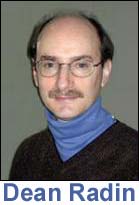
His segment, entitled Gut Feelings, portrayed his "efforts" to study just that. Now I may be just a layman, but I can tell when someone is trying to sell me slightly damp land. He proceeded to show his experiment which consisted of one person in an isolated room with numerous physiological measurements taken throughout the test. This subject is apparently the "receiver." The other subject was in another isolated room watching a series of images displayed on a TV screen. These images were designed, Mr. Radin says (I refuse to call this quack a doctor even though he claims to have a PhD) in order to evoke an explicit emotional response in the "sender." Mr. Radin then was shown commenting on his interpretation of the results while watching video of the subjects and playback of the measurements taken on the "receiver." The host/narrator of this weekly "science" program Gillian Deacon commented on the "results" as if it were a legitimate study that might affect everyone's life in the near future i.e. a new drug that will dramatically reduce the incidence of x disease. To sum up, Mr. Radin insinuated that the changes in physiological measurements taken from the receiver that just happened to coincide with a couple of times that the "sender" saw dramatic images of fear, hate, sadness, etc. proved that the receiver subject was actually receiving information from the sender via her "gut."I'll tell you, Mr. Randi, this hogwash was truly disturbing. Neither the host nor the producers of the show ever asked any questions! At one point the receiving subject said she felt hungry during the test and this Radin character actually said that this proved she received the sender subjects emotions and translated them into hunger pangs?! I started laughing so hard I cried. This is a perfect example of what happens when rigorous controls are no longer applied to science. What you get in the end is simply no longer science.
P.S. I just recently discovered your website along with seeing Penn & Teller's B.S. show. I tune in to both now once a week and no longer watch the Discovery Channel after what I saw this morning.
Mark, don't give up entirely on that channel. They produce some good shows, too — though I can't think of one right at this moment. Write and tell them what you think!
Here's part of a typical exchange that I go through with people who ask dumb questions....
A would-be applicant wrote to me:
I'm going to make this a little less formal.I'm not getting why you're not understanding the questions, I thought I have been making them clear. I apologize if it seems as if I've been wasting your time.
How would you test someone who has random dreams of the future, but doesn't know what dreams will come true until they actually occur?
My difficulty in figuring this out is because I did not know you, I did not know your organization, and I didn't know how they run things, I was curious but my efforts to having a simple polite inquiry have been shot down.
She also asked me how I would test her ability to predict the gender of unborn babies — without sonograms or enzyme tests, of course — followed by the tiresome, ubiquitous, denial of financial interest:
I'm not interested in your money Mr. Randi.... etc.
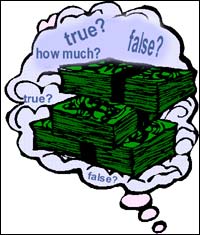 I responded:
I responded:
Get real! You're saying that the dreams that come true, are prophetic, while those that don't, are NOT prophetic!What I cannot understand, is how you have a hard time figuring out how to test whether or not a person can predict the sex of an unborn child! TEST THE CLAIM! Can't you imagine how that would be done....?
Your questions don't require answers! Those answers are OBVIOUS.
She wrote back in answer....
Yes Mr. Randi that is the difference between precognative [sic] dreams and normal dreams, the ones that do come true are prophetic while ones that don't... aren't. Though that wasn't the question I was asking... most of the time the prophetic dreams are completely random, it would be hard to test that... almost impossible. . . .Obvious; the obvious Mr. Randi is that you are impertinent, though I have explained my questions repeatedly in a fashion I found to be completely understandable you still respond with e-mails that don't have any relavence [sic] to the prior e-mail and are filled with bitter condesening [sic] words that are frankly, out of line and completely rude.
You are an impossible man, but still I will be polite and thank you for your time; however I am not requesting anymore of it.
Hallelujah....
As promised, here is the short video clip of our intern Jacob Spinney doing a minor miracle, a trick which is his invention. After you've decided how you think this was accomplished, consider:
1. There was no editing of any sort done to this video.
2. The fork is an ordinary restaurant-use stainless steel item.
3. No chemicals, magnets, or hi-tech means, were used.
4. There was nothing for Jacob to get rid of, following the bending, and he’s standing well out from the bookcase in the background, which in any case does not enter into the procedure.
5. No special lighting was used when making the video.
6. The fork can be examined and then handed to Jacob by a spectator and immediately bent, as shown.
7. The fork is not prepared beforehand in any way.
8. The fork can be thoroughly examined by anyone before and after the demonstration.
9. The fork is immediately ready to be handed out for examination following the demo.
10. The spectator can then walk away with the fork, and be none the wiser.
That should get around some of the more obvious ideas that could be offered, but no, we're not going to give you a solution to the trick. It's a great idea, original with Jacob, and it will probably be used professionally by magicians — and maybe even by "real" psychics whose bending skills are not sufficient....
So that Jacob can get some valuable opinions about this trick, we'd like to invite your comments at Jacob@jacobspinney.com. Jacob will answer personally — with everything but the modus operandi....
Click here to view the video.
Note: Do to the close-up nature of the trick, we present it in a fairly large format. The download is over 11 MB.
Reader Craig Rowland:
I enjoyed reading your comments about many of the dubious claims that are so widely accepted in "Audiophile" circles. One well respected Audio Engineer, John Dunlavy of Dunlavy Audio Labs fame (now defunct) [the lab, not John!] had this to say about "Cable Nonsense" a few years back:
Oh yes, we have heard of golden-eared audiophiles who claim to be able to consistently identify huge, audible differences between cables. But when these experts have visited our facility and were put to the test under carefully-controlled conditions, they invariably failed to yield a score any better than chance. For example, when led to believe that three popular cables were being compared, varying in size from a high-quality 12 AWG ZIP-CORD to a high-tech looking cable with a diameter exceeding an inch, the largest and sexiest looking cable always scored best — even though the cables were never changed and they listened to the ZIP Cord the entire time.
Read it all at www.verber.com/mark/cables.html.One particular company I've had fine dealings with in the world of audio amplification is Bryston, at www.bryston.ca. Not only are they against audiophile nonsense, they will gladly have their engineers answer questions you may have about audio products — although they are careful not to speak too negatively. When I was speaking about audio cabling with them in the past I asked what speaker cables they recommended (Their selection here wasn't available at the time: www.bryston.ca/cablememo.html). They told me to buy some 10-gauge Zip line from a hardware store for cheap. When I joked that their solution was too cheap and surely they have some expensive cable to sell they told me to send them a check for whatever amount I felt was reasonable! It's no wonder that so many professional audio mixing houses use their equipment in their studios.
This is not an endorsement for Bryston, but it was part of Craig's posting, and I don't mind plugging a company that uses common sense rather than hype and pseudoscience in their advertising.
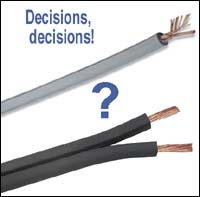 Reader Jaime Arbona was more direct on the same subject:
Reader Jaime Arbona was more direct on the same subject:
Don't waste your time. Audionuts, er, audiophiles have decided (long ago) that they won't participate in (ugh!) double blind tests because they are, among many other things, too stressful and contrived. They claim that in this kind of test they cannot hear the subtle musical nuances that distinguish some components from others and so they get random results (Don't dowsers claim something similar?) They can only tell the difference when they know which component is being used. Besides, audio reviewers will never admit the truth, since they make a living out of telling audio magazine readers which component sounds better. They also have a mag to sell.
Jaime then cites the above John Dunlavy piece....
An anonymous reader:
I saw these messages and they mention your name so thought you might like to read them for entertainment. Seems you have some sort of "energy field" around you that makes free energy permanent magnet motors stop.That must be similar to the "field of the video cameras that damped the field of the Searl flying disk." Story was "Professor Searl" claimed to have some magnetic disks that would be self-propelled and fly. When a video TV crew came out to see them in the UK, it didn't fly. He claimed the field from their video cameras damped the field of his flying disk and thanked them for showing him a way to control it, because all his previous models got started and just flew away out of sight.
Don't you just hate it when that happens? The reader continues:
Both of these fellows are crackpots with claims of "free energy", UFO, etc. Elias Reminton arkresearch@hotmail.com claims to have phase converters that convert single phase electric power to three phase AND make more power doing it, and other technology.Interesting point is that Elias seems to be SKEPTICAL of other's claims. "My device works but all those other free energy devices do NOT WORK," seems to be common among alleged "free energy inventors."
Here are a few comments they made re "Amazing Water":
Shape has a resonant value, water responds to such VALUE ... microwave waveguide design and acustic [sic] knowledge is verry [sic] helpfull [sic] here ..The operator effect factor and ambient ones must be eliminated ...
Just try to operate a PM motor in front of James Randy [sic] ... You will definitely understand my point ... Unit froze dead as he entered room, (from private test report in undisclosed location...)
Randi comments: This simply never happened. I've never been offered a demo of such a device. Next they deal with Emoto's silly claims, which we've handled here on former pages....
This is a interesting study on the properties of water. Dr. Masaru Emoto has been studying the changes of water crystals when it is exposed to different environments. In one very interesting experiment, he taped a piece of paper with a word or phrase written on it to a clear bottle of water and the resulting different crystals that formed from this are amazing. Go to this link to see the photos and read what words were used. http://www.mercola.com/2002/may/8/prayer.htmMaybe this would explain why some researchers are not able to get free energy devices to work while others can. Their thoughts and bio-field could be interfering in some way, maybe they are holding negative energies or feelings. Understanding this might open a door to developing free hydrogen technology from water. Perhaps the water needs to be conditioned prior to being separated into hydrogen/oxygen gas.
 I hope Jacob will be getting good feedback from you folks on his demo shown here. It will soon be on the market, and I'm expecting a good reaction and heavy sales for him. Let us know.
I hope Jacob will be getting good feedback from you folks on his demo shown here. It will soon be on the market, and I'm expecting a good reaction and heavy sales for him. Let us know.
As we "go to press," the sad news reaches us from colleague Massimo Polidoro that parapsychologist Dr. Bob Morris died this morning from a sudden and unexpected heart attack. As Massimo said, he certainly was a very reasonable parapsychologist. Bob was appointed to the Edinburgh University Koestler Chair in 1986. He was widely respected and trusted. I very much regret his loss.
